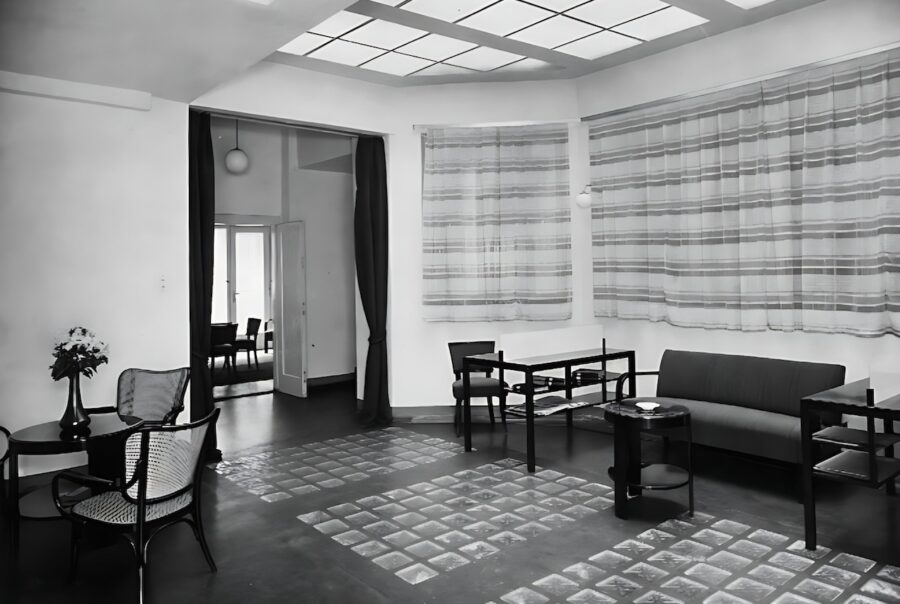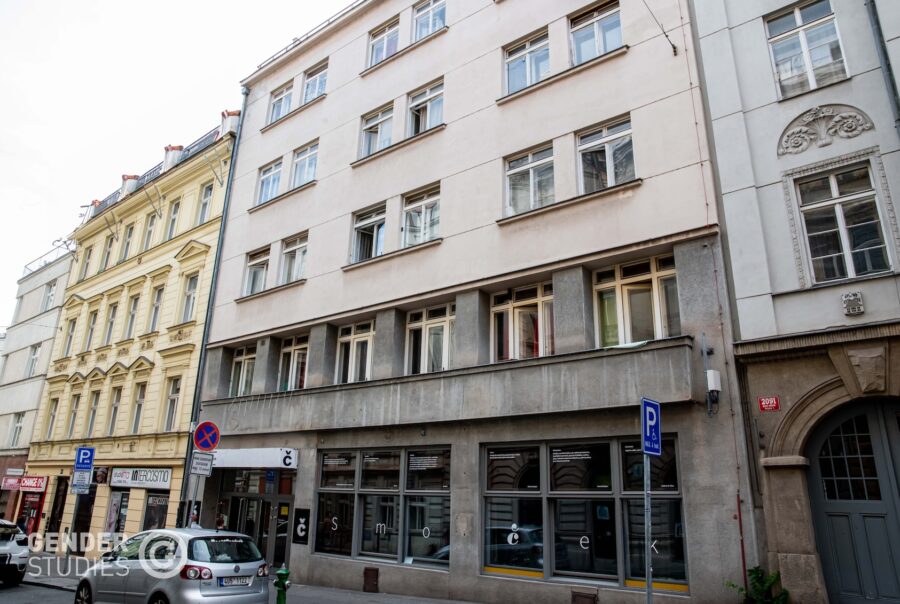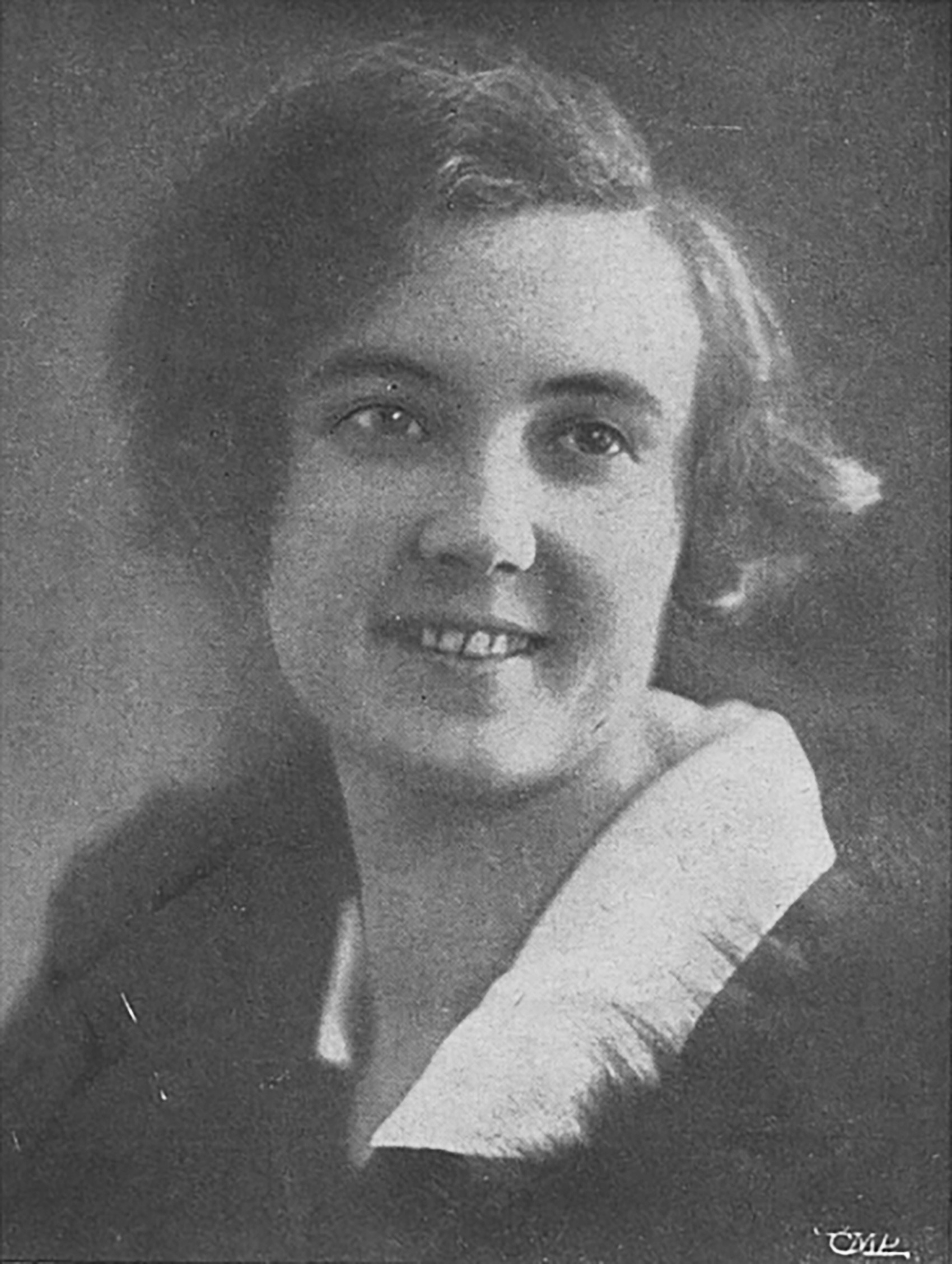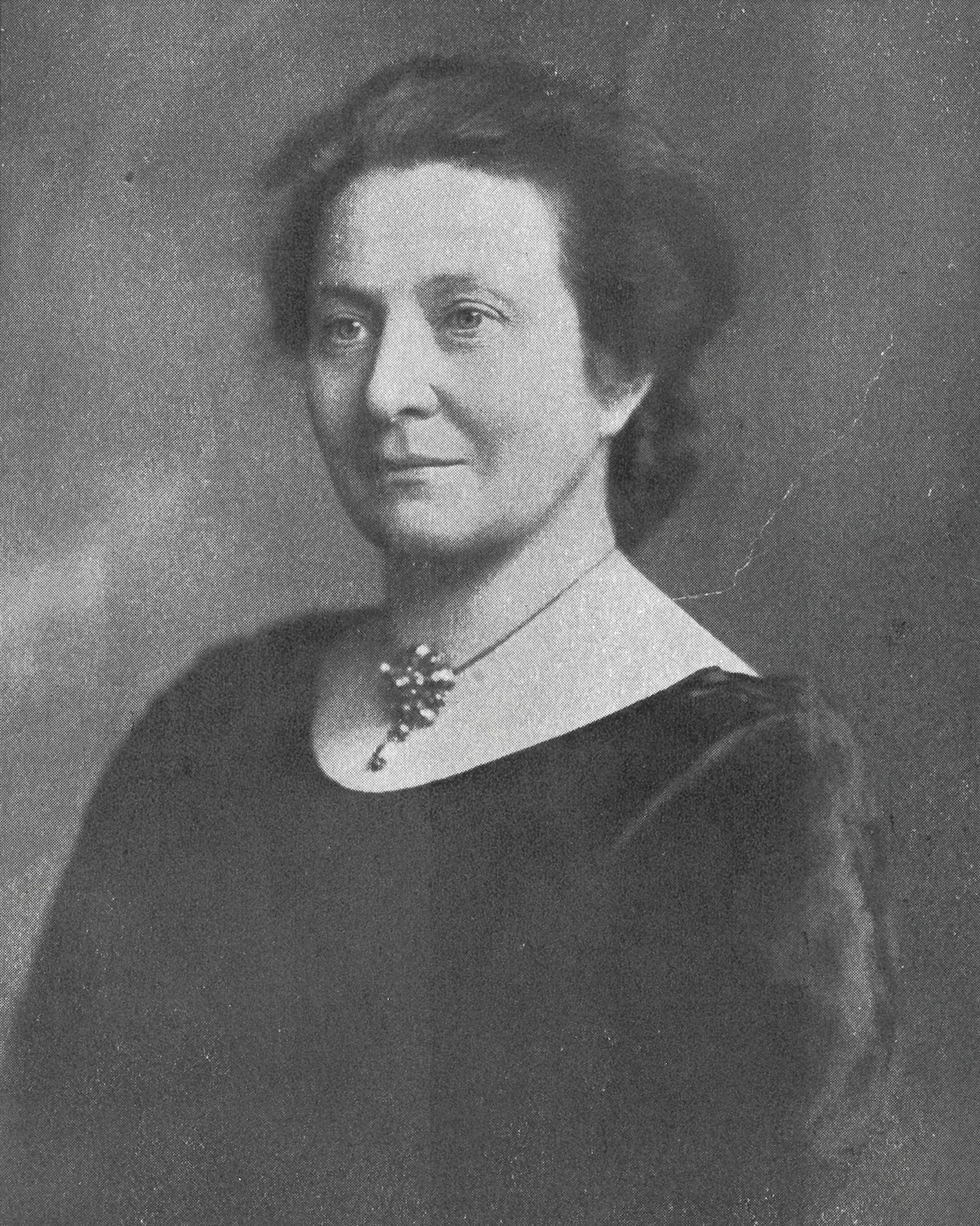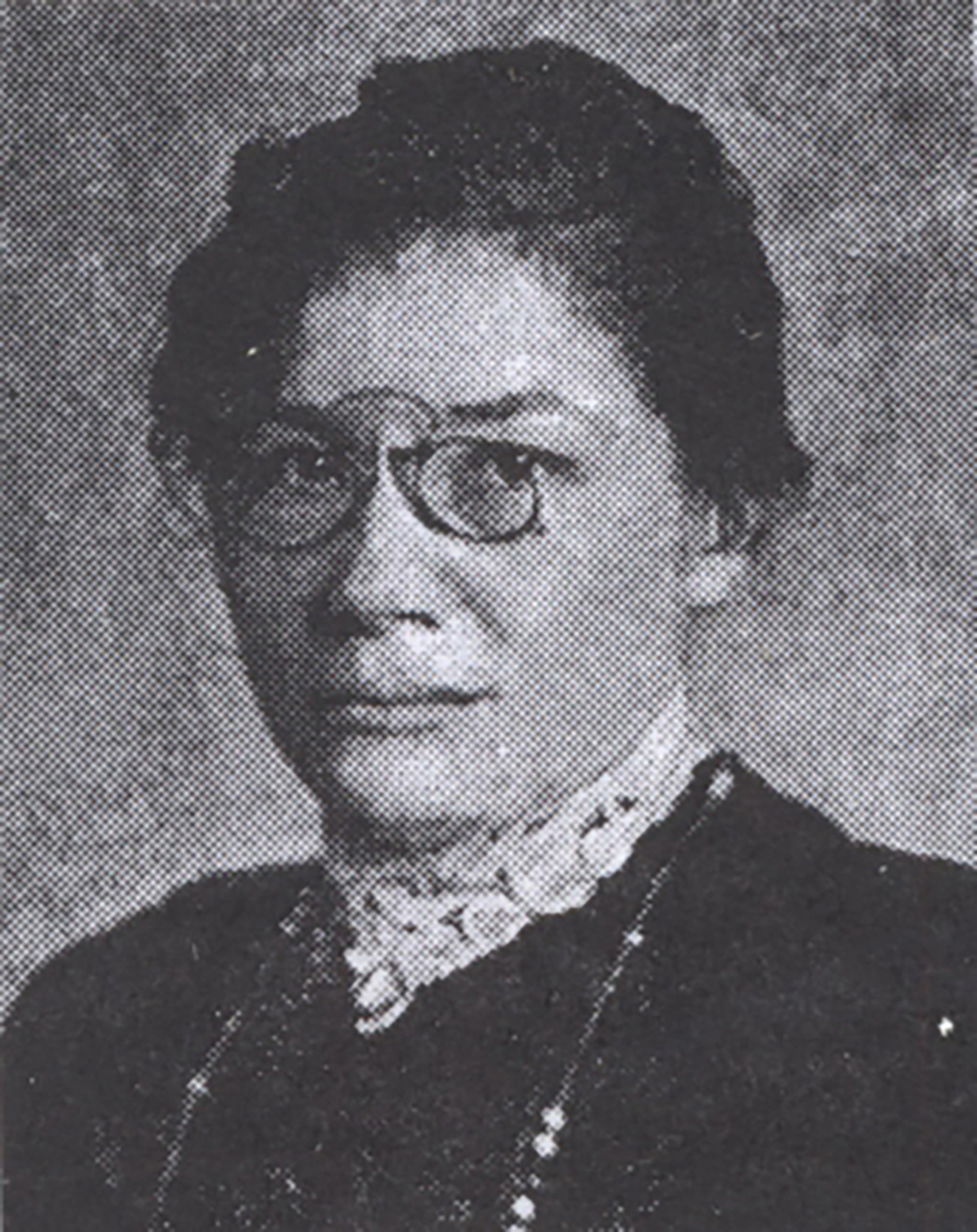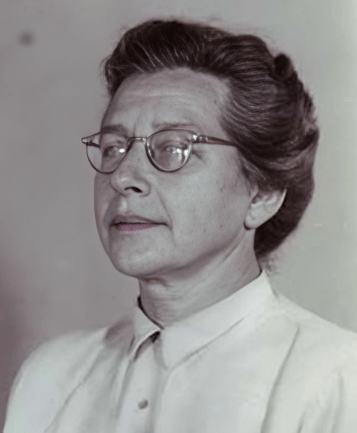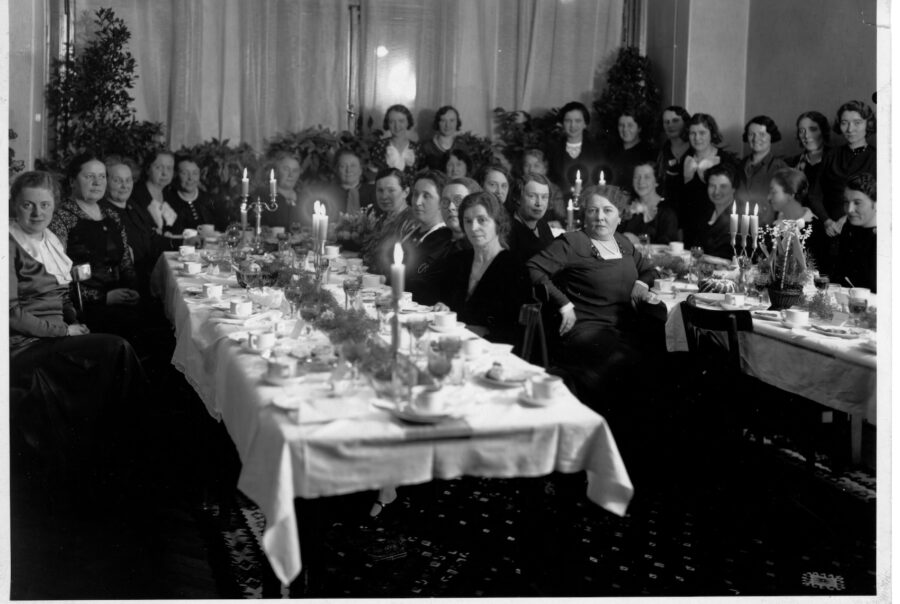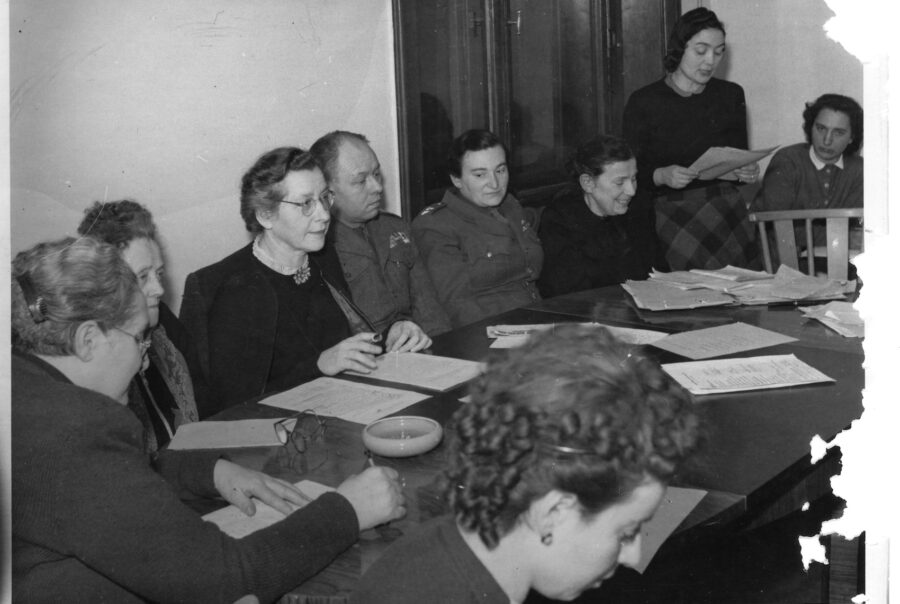The history of this building dates back to the year 1928, when the Czech Women’s Club (co-founded by Charlotte Garrigue Masaryk) decided to build its own community centre. A cooperative started for this purpose issued share certificates for sale to individual members. Another part was funded by credit paid from membership fees. Important roles in the project were played by Senator Františka Plamínková, social worker and Czechoslovak Red Cross founder Alice Garrigue Masaryk, and the first Czech female architect Milada Petříková-Pavlíková, who was a club member and created, without recompense, the design of the building including its interior equipment.
Finally, in 1933, the Club opened a multipurpose functionalist building with club lounges, a library, a lecture hall, women’s quarters, and a restaurant. The rather humble quarters came with a single shared kitchen for the entire building and one shared bathroom per floor. All the premises were dedicated exclusively to women; men could only access the restaurant, which also served vegetarian meals. The entire building is true to the functionalist style. It features an extremely simple, undecorated façade, and the interior exhibits the same purity of style. The floor plan is defined by an octagonal central area with a staircase extending from the basement to the attic. The staircase still has well-preserved tube handrails.
A number of women’s organizations held their educational activities in the community building, and individual women had access to dormitory-style accommodation. The Czech Women’s Club operated without problems till the outbreak of WWII, when the building was seized by the Nazi regime and many members got arrested; Františka Plamínková was executed. While Milada Horáková took on Plamínková’s role in the Club, the communist regime after 1948 took a generally hostile attitude to free association – women’s clubs were now considered mere bourgeois entertainment. Following the arrest of Milada Horáková in September 1949, a general meeting was swiftly convened and amidst an atmosphere of fear, the association dissolved itself on the very same day. When the Ve Smečkách building became government property in 1955, it continued to serve as women’s quarters. In the early 1960s, its former lecture hall became the seat of the Činoherní klub theatre.
In 1990, the Czech Women’s Club was re-established and applied for its building to be returned. In 1998, feminist organizations organized a rally and started a petition to support the return effort. Speakers formulated the reasons behind contemporary feminist organizations’ moral and material right to the community building. To women’s organizations, the house is closely associated with women’s emancipation and important leaders such as Františka Plamínková or Milada Horáková. However, the return effort failed because in restitution proceedings, the court did not acknowledge the re-established Club as a legal successor of the founding cooperative. This meant a lost opportunity for bringing all feminist collectives together under one roof.
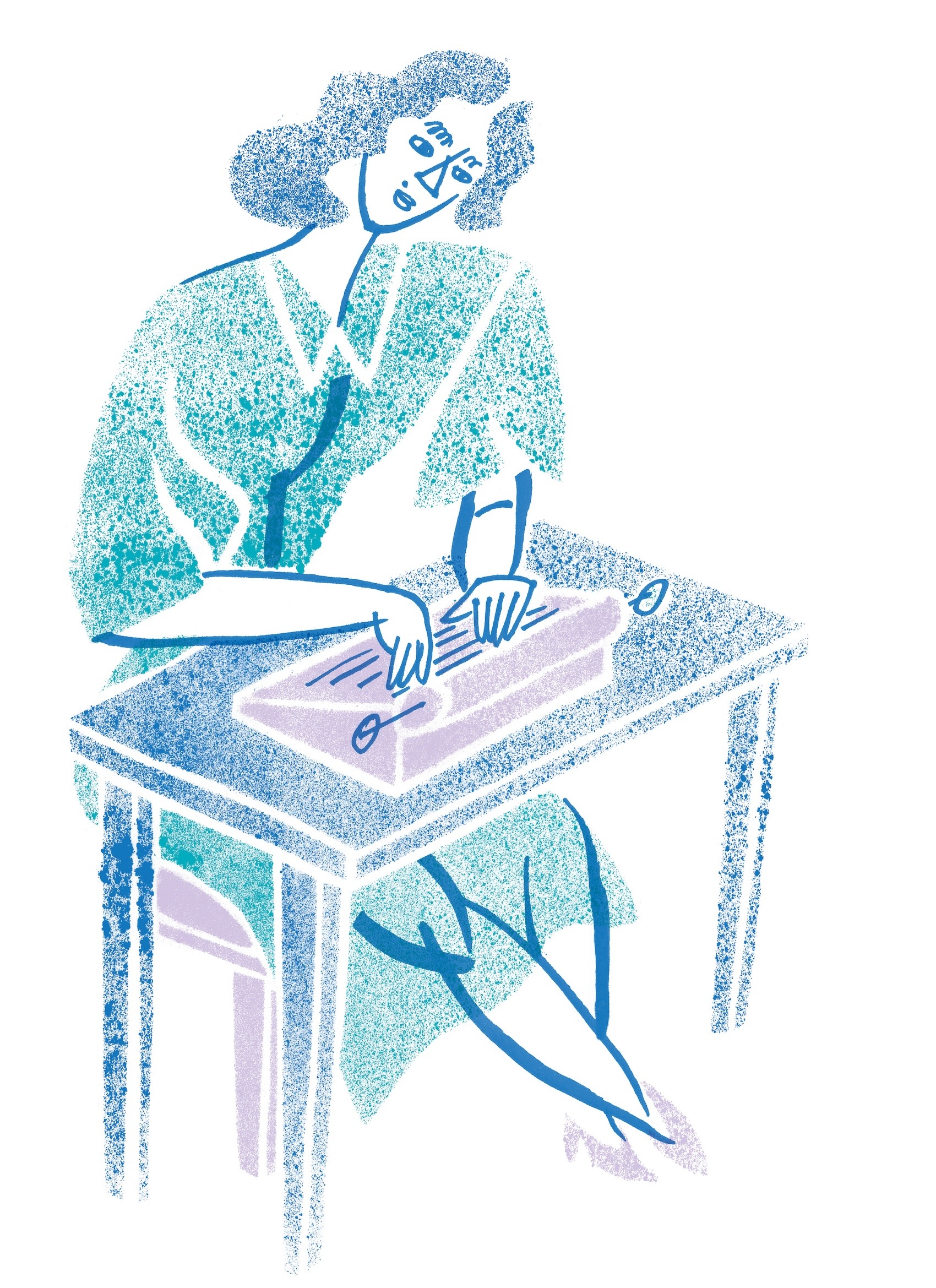
Listen to the whole story of Anna Kovář (Czech only)”How did I become Františka Plamínková's secretary at the Czech Women's Club in Ve Smečkách?
Milada Petříková-Pavlíková
(1895–1985)
first Czech female architect
“Life is very joyful in the dormitory, and I sense that the residents feel happy. Perhaps even those living more difficult lives will find help in the community to better overcome their troubles.” (Milada Petříková-Pavlíková: Byt samostatné ženy [The independent woman’s flat], in: Jak bydleti [Improving one’s housing], a lecture course held by the Women’s National Council, Housework Optimization Section, Praha 1935).
She was born in 1895 into a patriotic physician’s family in the town of Tábor. She graduated from the Minerva Gymnasium. Milada was strongly influenced by her aunts, the first Czech female physician Anna Honzáková and a long-term collaborator of Eliška Krásnohorská and Minerva teacher Albína Honzáková. In 1914, she started studying architecture, first as a private tutee, as the Austro-Hungarian law did not yet permit women to become regular students at technical colleges. In 1921, she became the first woman in Czechoslovakia to obtain the architect’s degree (Ing. arch.). She primarily focused on social housing. For example, she designed a rental building for single women in Prague’s district of Dejvice or a women’s shelter built in the name of Charlotte Garrigue Masaryk. The seat of the Czech Women’s Club, which served as a community centre of the Czech women’s movement, represents one of her most significant works.
Františka Plamínková
(1875–1942)
democratic socialist politician, parliamentarian, journalist, teacher, feminist
“The woman still has to struggle for the right to work, she is faced with extra obstacles in her access to higher professions, and she is less likely to be promoted. Her position becomes much worse if she is married. This is my way of saying, in general terms, that the theoretical equality of women has not been thought through and implemented in everyday practice… I wonder if even the smartest, most educated women realize they are actually living under the pressure of inferiority”. (Františka Plamínková in an interview for a female social workers’ journal, 1935)
Františka Plamínková was a Czech politician, member of the democratic socialist National Socialist Party, parliamentarian, journalist, teacher, feminist, and organizer of the Czechoslovak and international women’s movements. She became one of the key figures in the history of women’s emancipation. Born in 1875 into the family of Prague shoemaker František Plamínek and Františka Plamínková née Krubnerová, she graduated from an official programme of teacher’s education in Prague and worked as a teacher and journalist for many years. She joined the Women’s National Council (Ženská národní rada), an umbrella organization for women’s associations to coordinate feminist activities, where she collaborated with Milada Horáková, among others. Františka Plamínková also helped abolish female teachers’ celibacy (in 1919) and introduce women’s suffrage (in 1920). She openly opposed the Nazi regime. For example, during the Sudeten Crisis of 1938, she wrote an open letter to Adolf Hitler denouncing the accusations that President Edvard Beneš engaged in murdering ethnic Germans. Since she refused to denounce the assassination of Reinhard Heydrich, among other things, she was imprisoned and executed by the Nazi regime on 30 June 1942.
She developed a great deal of social conscience and considered herself a democrat and humanist. She initiated the construction of the seat of the Czech Women’s Club and the Women’s Homes (Ženské domovy) for working singles in Prague’s district of Smíchov , or the so-called Red Houses in the district of Holešovice (a participatory housing project with a common cafeteria, crèche, kindergarten, and gymnasium). She attended international congresses and conferences supporting human rights and women’s emancipation. For many years, she served as vicepresident of the International Council of Women, in the International Women’s Suffrage Alliance, or in the International Federation of Business and Professional Women. She supported women’s education and equal position in paid employment and political life, protection of working-class women and female clerks, equal rights for children born out of wedlock, the right to maternity leave, dignity in childbirth, a ban on human trafficking, or efforts to maintain peace. Thanks to these activities, she won respect around the world.
Františka Zeminová (Fráňa Zemínová)
(1882–1962)
democratic socialist politician, parliamentarian, feminist, resistance fighter, and political prisoner
“The laws of fallen Austria prevented women from fully developing their female individuality. The imposition of female teachers’ celibacy (…) undercut the liberty of female teachers. As a result, female teachers cannot freely and independently exercise their genuinely human rights. (…) The concerns that a woman pursuing a profession could not be a good wife or mother is proven wrong by countless analogies of businesswomen, craftswomen, and female factory workers. (…) For these reasons, we propose abolishing celibacy for female teachers at public schools in the Czechoslovak Republic.” (Františka Zeminová’s parliamentary speech, 1919)
Františka Zeminová was an important Czech politician, member of the democratic socialist National Socialist Party, and leader of the women’s movement. Born in 1882 into a farmer’s family in a village near Kolín, she was the youngest of 12 children. After studying a business-oriented secondary school in Prague, she worked as a bookkeeper and retail assistant at a publishing house. As early as at the age of 15, she entered political life by joining the democratic socialist Czech National Socialist Party. She was active in the Czech Women’s Club and co-founded an association of women workers in 1901. In 1905, she joined Františka Plamínková in establishing the Women’s Suffrage Committee (Alice Garrigue Masaryk was also a member). She gave regular lectures and wrote for a number of periodicals. In the years 1918–1939 and 1945–1948, she was member of the National Assembly, thus becoming Czechoslovakia’s longest-serving female parliamentarian. She also worked as vice-chair of the National Socialist Party (later renamed to Socialist Party) and head of the party’s women’s chapter.
She advocated for social policies and social equality for women, playing an important role in abolishing female teachers’ celibacy, transforming girls’ schools into public schools, and supporting women’s political activity. She was renowned for her intelligence, sharp tongue, energetic rhetoric, and courage. During World War II, she joined the Czech resistance and took part in the Prague Uprising. After the war, she resumed her office as vice-chair of the National Socialist Party and head of its parliamentary party group. After publicly criticizing the politics of the Communist Party, she gave up politics following the coup d’etat of 1948. She was monitored by the secret police and later arrested as part of a show trial of Milada Horáková. The charges brought against her included high treason, espionage, preparing war, and anti-state conspiracy. In 1950, she was sentenced to 20 years in prison. After 10 years, she got released under a presidential amnesty of 1960. Suffering from ill health, she found refuge with her niece Anna Stránská, to whom she said at that time: “You know, I am like grass. No matter how much they trample it, it will get up again.” She passed away in 1962 in the spa town of Velichovky. In 1992, President Václav Havel awarded her the Order of Tomáš Garrigue Masaryk of the Third Class in memoriam.
Milada Horáková
(1901–1950)
politician, lawyer, member of the democratic-socialist National Socialist Party, women’s rights advocate
“Let a woman pursue her occupation of her own volition, to satisfy the need for self-actualization, rather then merely to help her husband provide for the family. Her education should focus not only on employment but also on raising one’s own children. If a woman wants to fully devote herself to the motherly role, then she has to be provided with security both legal and social.” (Milada Horáková)
Milada Horáková is generally known as a victim of the political show trials of the 1950s. An unshakable proponent of anti-totalitarian opinions, for which she bravely advocated until her very execution, she came to symbolize the anti-communist resistance after the Velvet Revolution of 1989. Despite being primarily associated with the resistance against the rising communist totalitarian regime, her contribution to women’s rights advocacy should not be ignored.
Milada Horáková was born in the city of Vinohrady, nowadays part of Prague, namely in Rumunská street 18/22, as one of the four children of Čeněk and Anna Král. She and her 16-years-younger sister, whom she took care of after their mother’s premature passing, were the only ones to survive to adulthood. In 1913, she started studying at the Franciscan, catholic, pro-Habsburg Real Gymnasium for Girls at Korunní street. In 1918, in anticipation of the disintegration of Austria-Hungary and the establishment of independent Czechoslovakia, she transferred to a secular secondary school (Dívčí lyceum a Vyšší reformní reálné gymnázium) at Slezská street, where she also graduated in 1921. Then she entered the Faculty of Law, Charles University, to graduate in October 1926. Shortly after getting her college degree, she married Bohuslav Horák. Thanks to his influence, the deeply religious Horáková and her parents converted from Catholic Church to the Evangelical Church of Czech Brethren. After their wedding, they moved to the neighbouring city district of Vršovice, and in 1933, Horáková gave birth to their only child, Jana, married name Kánská.
During her college studies, she made the acquaintance of Senator Františka Plamínková. Although Plamínková was a generation older, they became very close. Their relationship was based on shared ideal – advocating for women’s rights and democratic values. A few hours before her execution, Milada Horáková expressed how she related to Františka Plamínková, whom she called her “motherly friend”. It was probably Františka Plamínková who introduced the fresh college graduate Milada Horáková to the Czech Women’s Club and outlined a vision on how she could use her legal education in the fight for women’s equality and emancipation. In the Club and beyond, Horáková assumed a focus on legal and social issues.
Founded in 1923 at the initiative of Františka Plamínková, the Women’s National Council promoted the practical implementation of the women’s rights endowed in the country’s 1920 Constitution. Indeed, albeit formally established, equality mostly failed to manifest itself in practice. As one of the key leaders of the feminist movement in the Council, Milada Horáková first served indirectly, as a delegate of the Association of College-Educated Women, on whose behalf she met with President Masaryk in 1927 and 1929. Later, she chaired the Council’s committee for women’s status in laws and public regulations. The Council shared its seat with the Czech Women’s Club, Ve Smečkách 26, Praha 1, where it held its meetings and events advocating for women’s rights and social justice. Gatherings that were less formal but no less politically engaged were also held in Františka Plamínková’s flat at Palackého 2, Praha 1, especially whenever the times became less favourable to official events. The family home of Milada Horáková in the town of Černošice was used for the same purposes.
Although she joined the National Socialist Party in 1929, her main engagement remained in the non-partisan organizations of Women’s National Council and Association of College-Educated Women. Led by Františka Plamínková, she helped contribute to a public consultation on family-related provisions of the Civil Code. She also filed comments on new laws and amendments on equal treatment of women of various occupations in the labour market. However, neither the government nor the legislature discussed their comments until 1938.
Along with other Council delegates, she participated in several international conferences and congresses: Paris (1928), The Hague and Vienna (1930), Marseille and Geneva (1933), Dubrovnik (1936), and Edinburgh (1938). Milada Horáková also promoted her ideals of social justice within other domestic and international associations. She joined the Women’s Suffrage Committee to promote women’s real-life participation in political life and the Women’s International League for Peace and Freedom to advocate for women’s rights in general; and she also served in the Czechoslovak Red Cross.
After graduating from the Faculty of Law, she worked at Prague’s central office for social care, Ústřední sociální úřad, led by Petr Zenkl. She was responsible for youth care and management of funds raised from various foundations. She had to leave her job in the context of the Munich Agreement and the cessation of Czechoslovak borderlands to Germany: to create jobs for Czech men deported from the borderlands or banished from Slovakia or Carpathian Ruthenia, a 1939 law ordered married female civil servants to retire. After organizing the Council’s social assistance during the Great Depression, she now took on assistance to Sudetenland refugees. In 1939, she joined the anti-fascist resistance, cooperating with the resistance group Politické ústředí. Together with her husband Bohuslav Horák, she joined the illegal resistance group, Věrni zůstaneme (We Shall Remain Faithful), for which she recruited other Council members. She also set up safe houses, gathered intelligence, and helped draft the original manifesto of Věrni zůstaneme. However, she got compromised and on 2 August 1940, Horáková and her husband were arrested by the Gestapo. Originally prosecuting Horáková for her Council work, the Gestapo later exposed her resistance activities and subjected her to harsh interrogations and torture. For two years, she was incarcerated in Prague (Pankrác, Karlovo náměstí), and following the assassination of Reinhard Heydrich, she was transferred to the Theresienstadt Ghetto. She got to lead the infirmary, which gave her more freedom to move around the Ghetto and allowed her to reunite with Františka Plamínková. In 1944, she stood trial in Dresden, where a proposed death sentence was commuted to eight years of imprisonment. She served her sentence in a women’s prison in Aichach (near Munich) until the arrival of the U.S. military in April 1945.
She returned to liberated Prague on 20 May 1945 and met with her husband, who had escaped a death march, a few days later. The social upheaval of the time, along with an audience with President Beneš, motivated her to return to political life. When the Women’s National Council resumed its activities under a new name, Czechoslovak Women’s Council, Horáková became its president (after Františka Plamínková had been executed by the Nazi regime). She planned to transform it into a nationwide women’s organization with local, district, and regional offices and a Prague headquarters. The Council abandoned its predecessor’s non-partisanship and nominated leaders from the country’s four officially authorized political parties as its vice-presidents. In 1947, the Council launched a popular women’s magazine, Vlasta. She also worked with the Union of Liberated Political Prisoners and the Union of the Friends of the Soviet Union. Above all, then, she followed up on her pre-war membership of the National Socialist Party and became member of the Interim National Assembly (the country’s first post-war legislature). In the elections of 1946, she ran for the National Socialist Party and won a seat in the National Assembly, where she joined the Foreign Committee and the Committee on Constitutional Affairs. She voiced critical opinions of the Popular Courts (post-war criminal courts to exact retribution under martial law rules), social issues, and foreign policy (including subservient attitudes to Moscow). Therefore, she was soon on the radar of the communist-controlled secret police, StB (State Security).
After conflicts with Communist Party leaders, she was stripped of all her political and public offices in February 1948 and resigned from the National Assembly in protest on 10 March. She returned to her work in social care, getting an office job in Prague’s local administration. Instead of leaving her country, she maintained contacts with exile politicians, helped others emigrate, and worked on a new political manifesto. As a political dissident, she was targeted by StB’s sweep, Operation Centre, and was arrested in her Masná Street office on 27 September 1949. Her husband managed to escape the sweep made in their home. Milada Horáková and her 12 colleagues were put on a show trial from 31 May to 8 June 1950. Perhaps due to her firmness, she became the only woman to obtain the penalty of death by hanging, which was executed on 27 June 1950.
The ruling was set aside by the Supreme Court in 1968, and it was not until 1990 that Horáková was fully rehabilitated. Posthumously, she obtained a number of important awards, and the day of her death became the official Day of the Victims of Communist Regime. Although her remains were never reliably found, a symbolic grave with her bust was established at the Vyšehrad National Cemetery (Praha 2). The Victims of Two Totalitarian Regimes Memorial in the Ztracenka Garden (unveiled in 2018) uses Milada Horáková as its central symbol.


